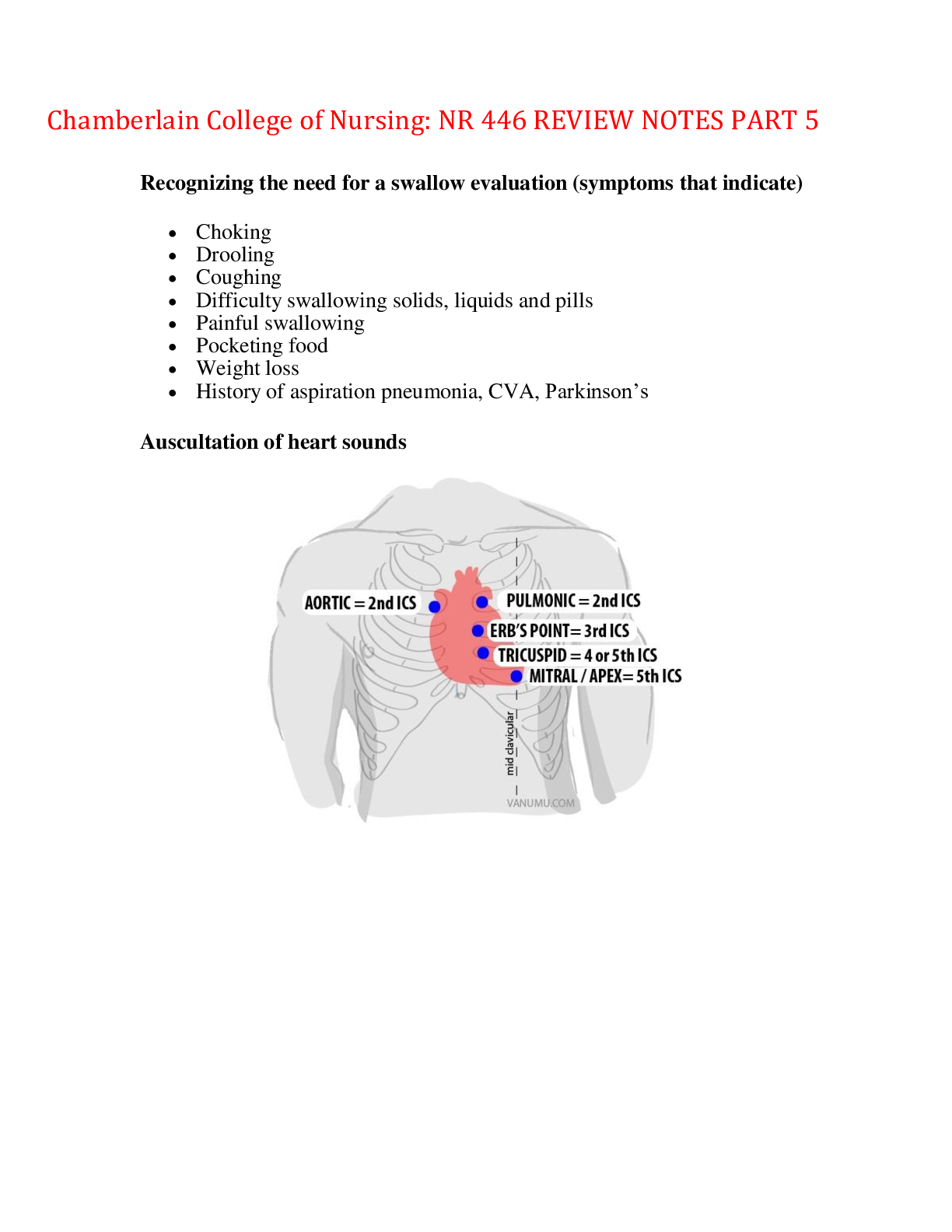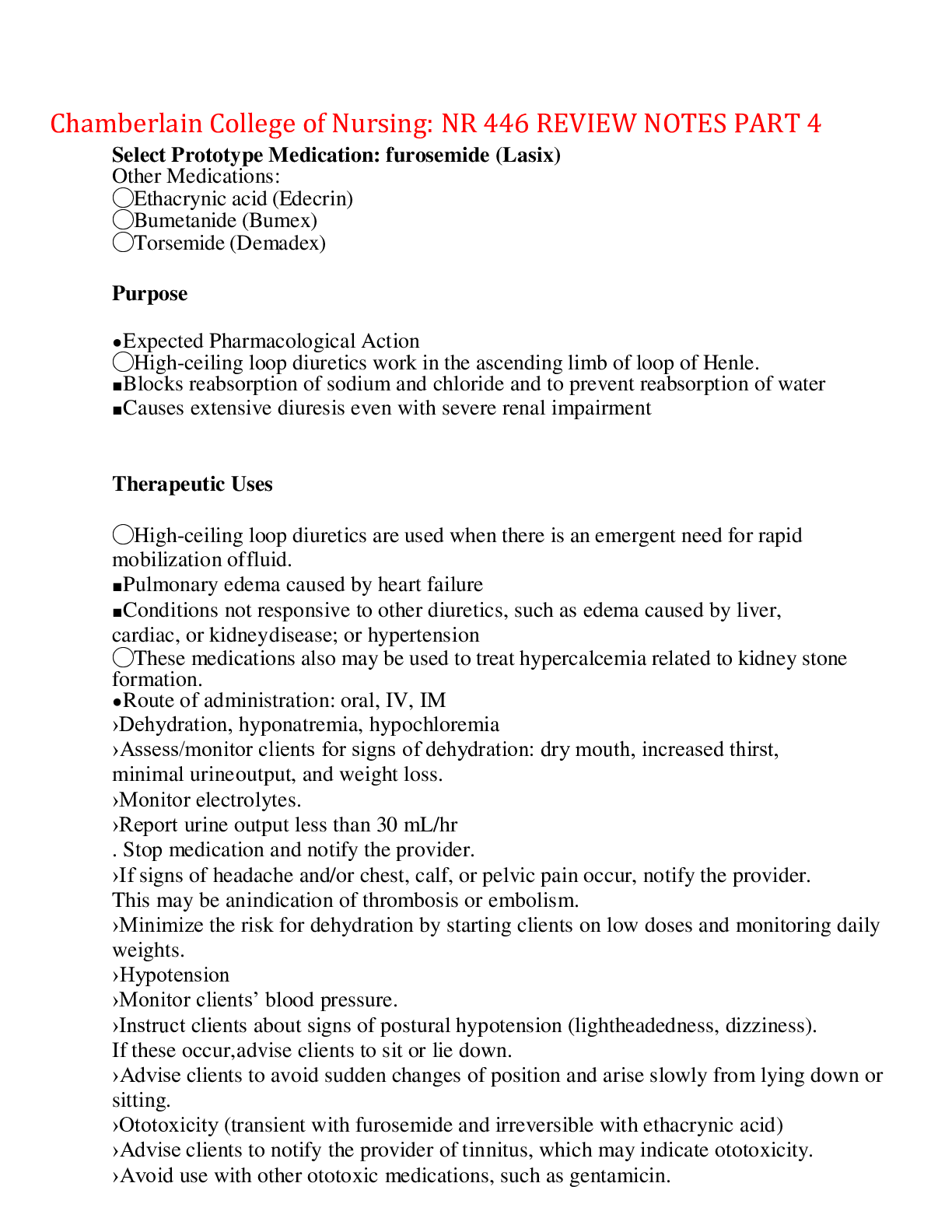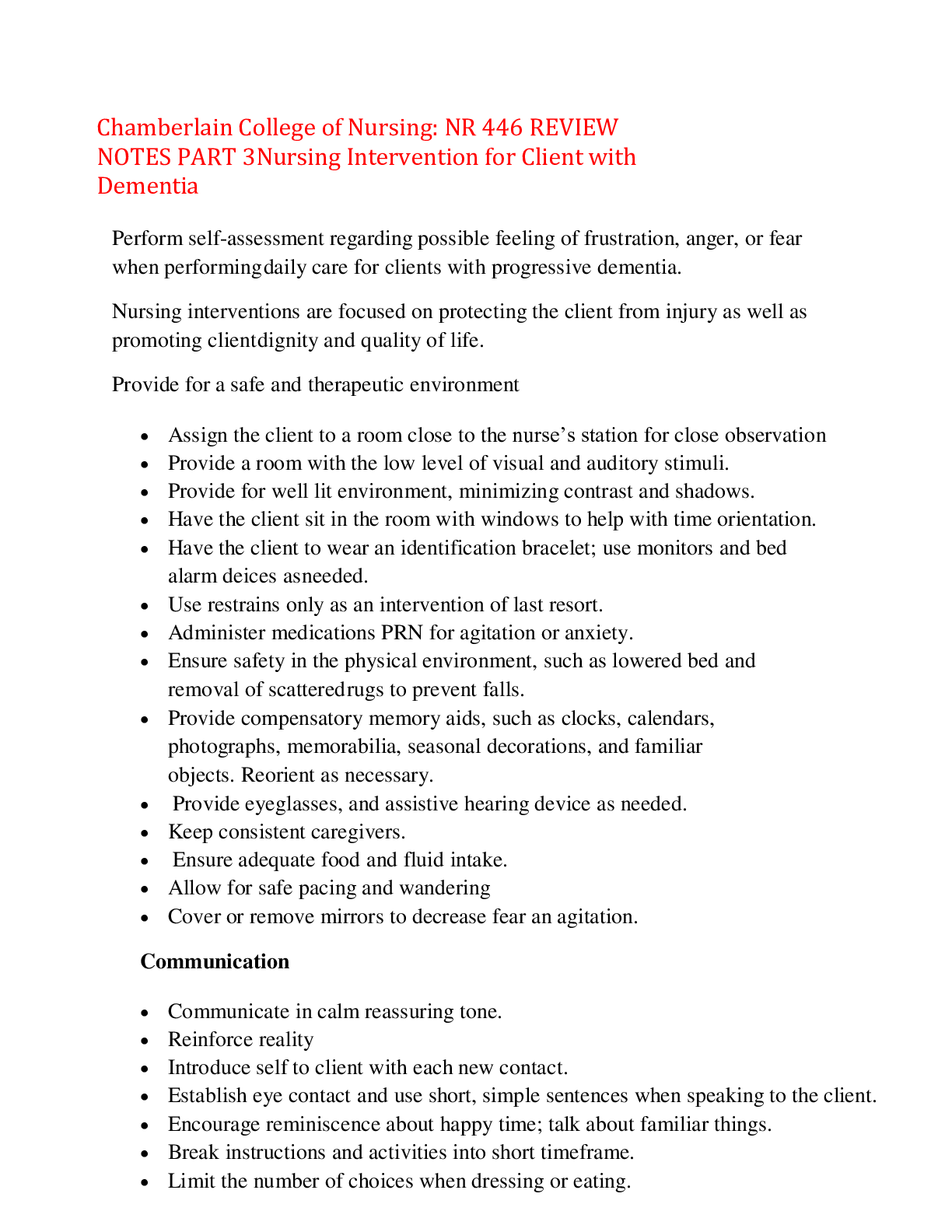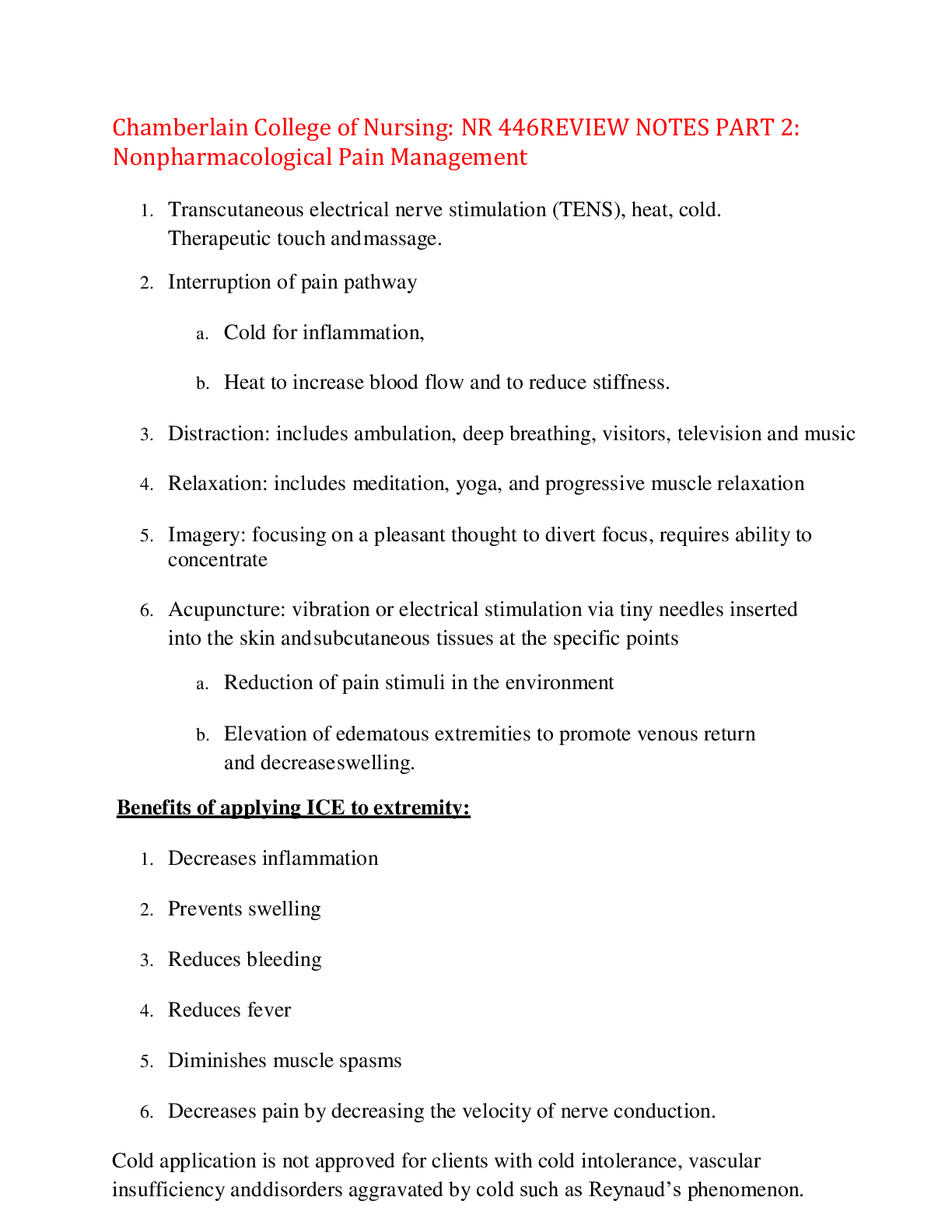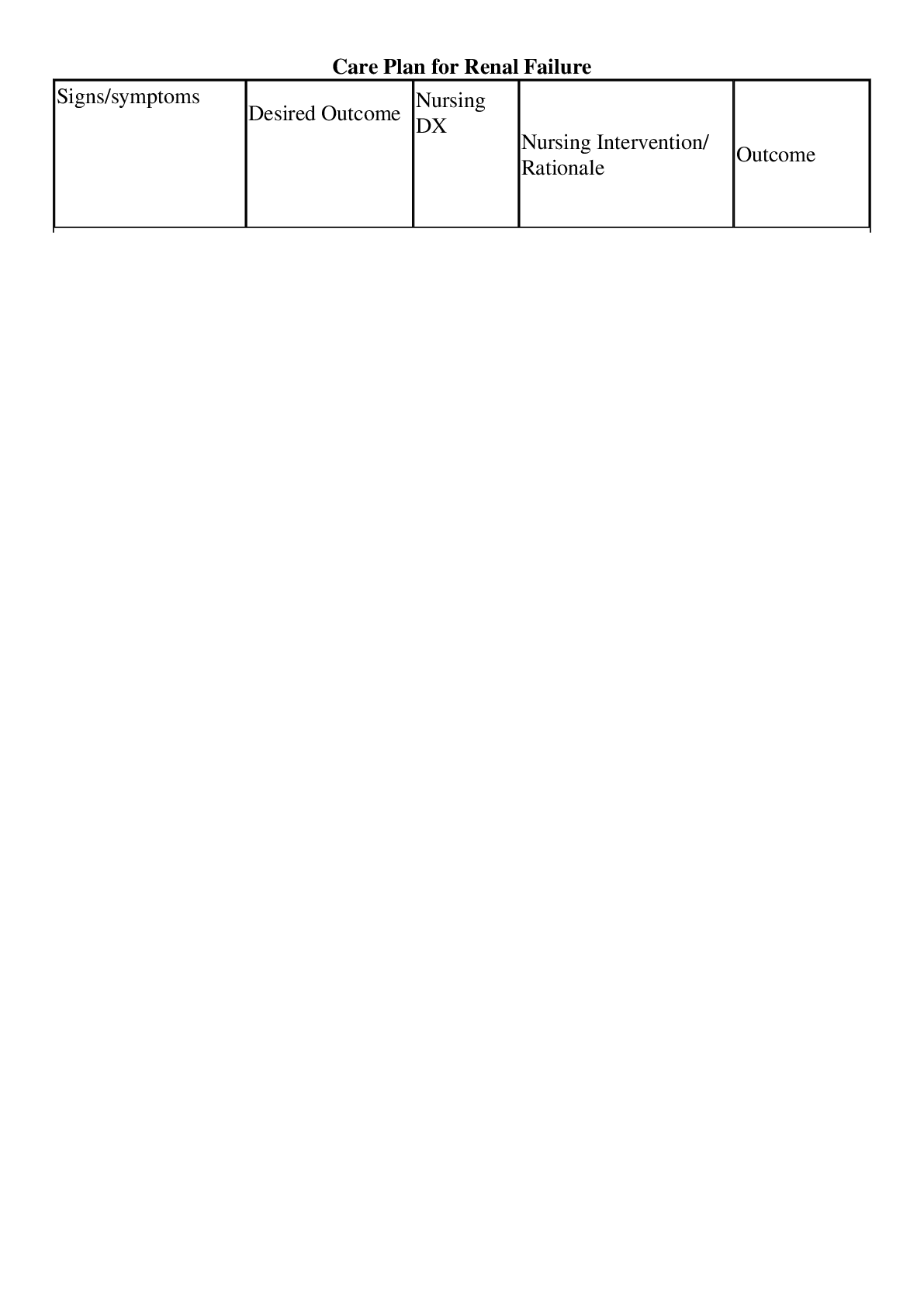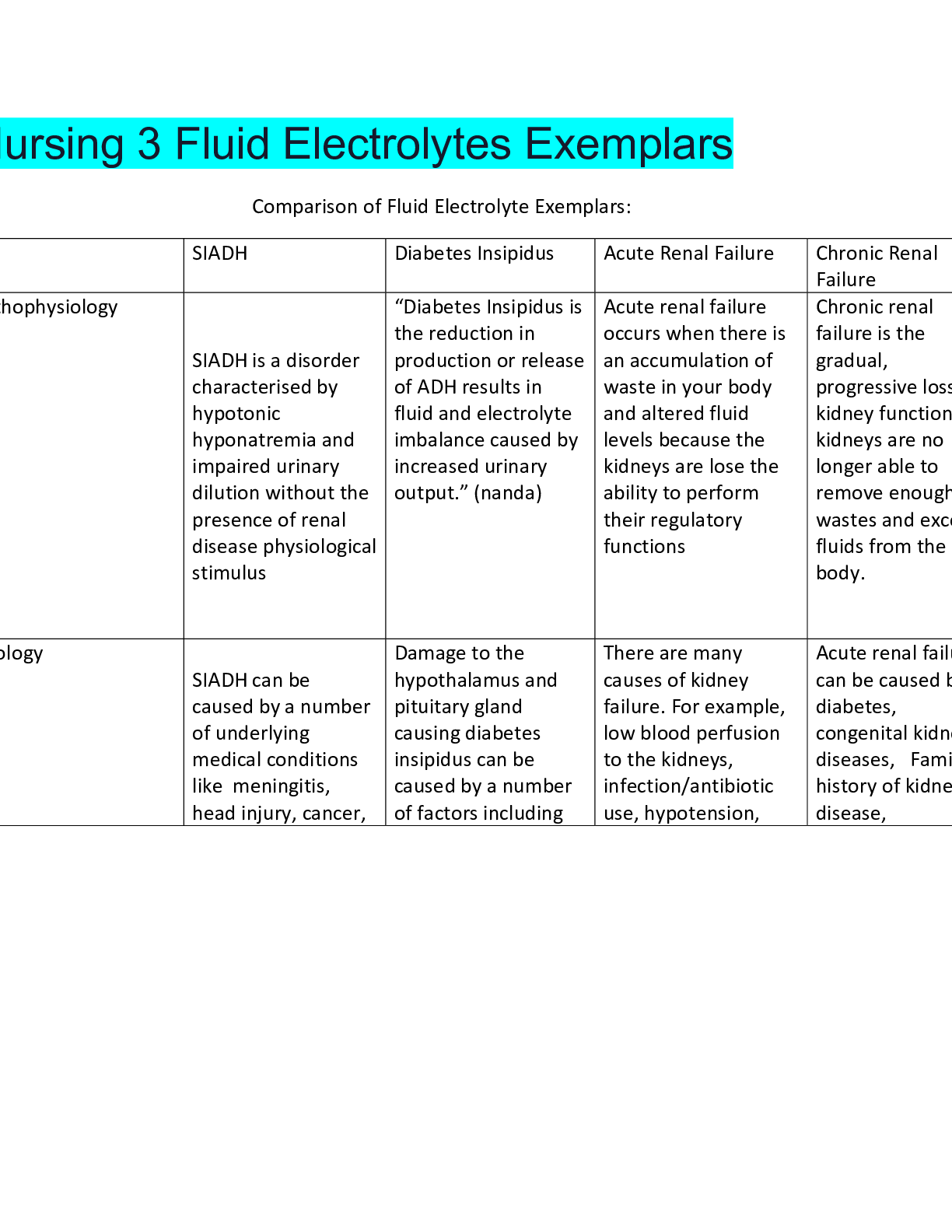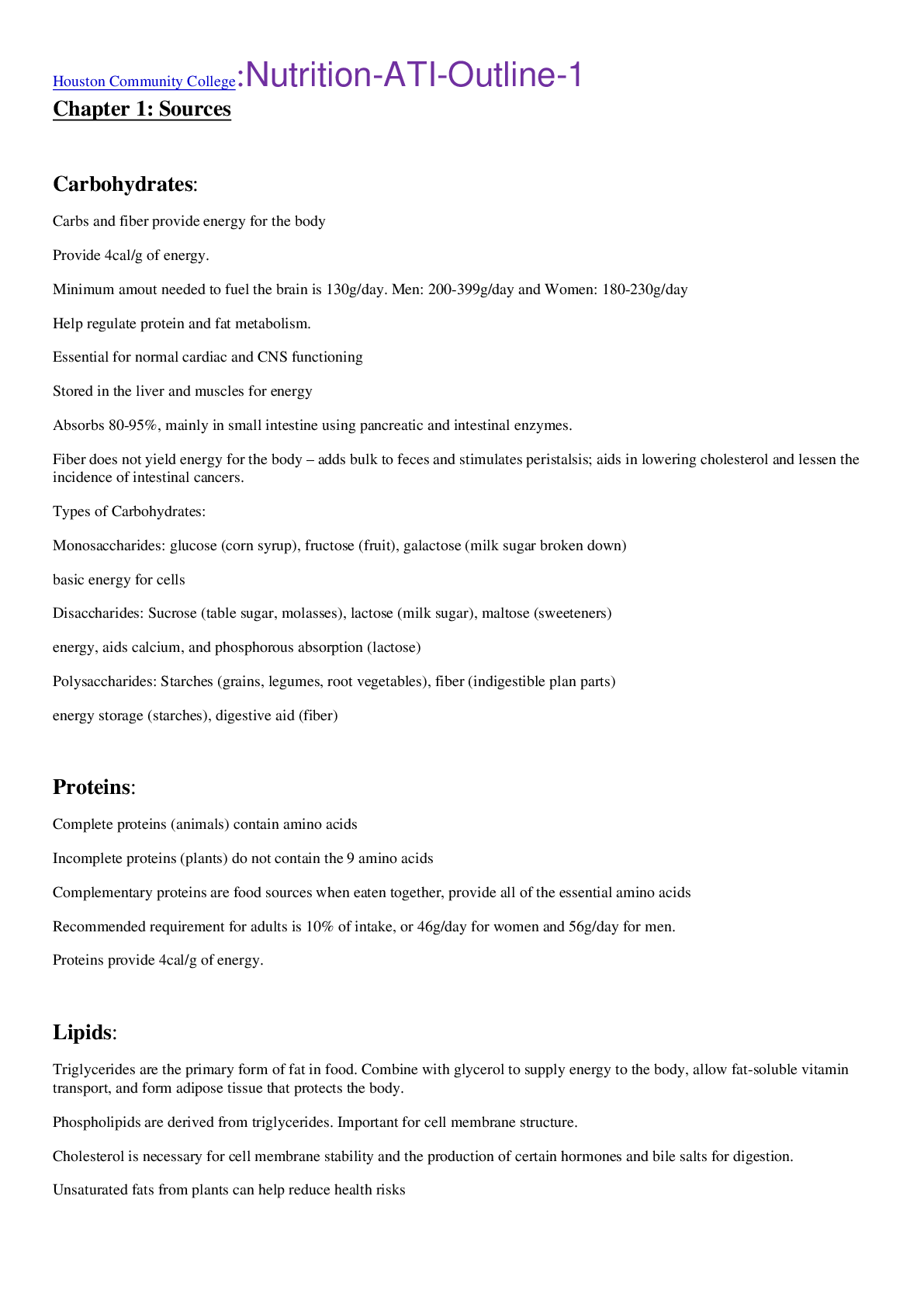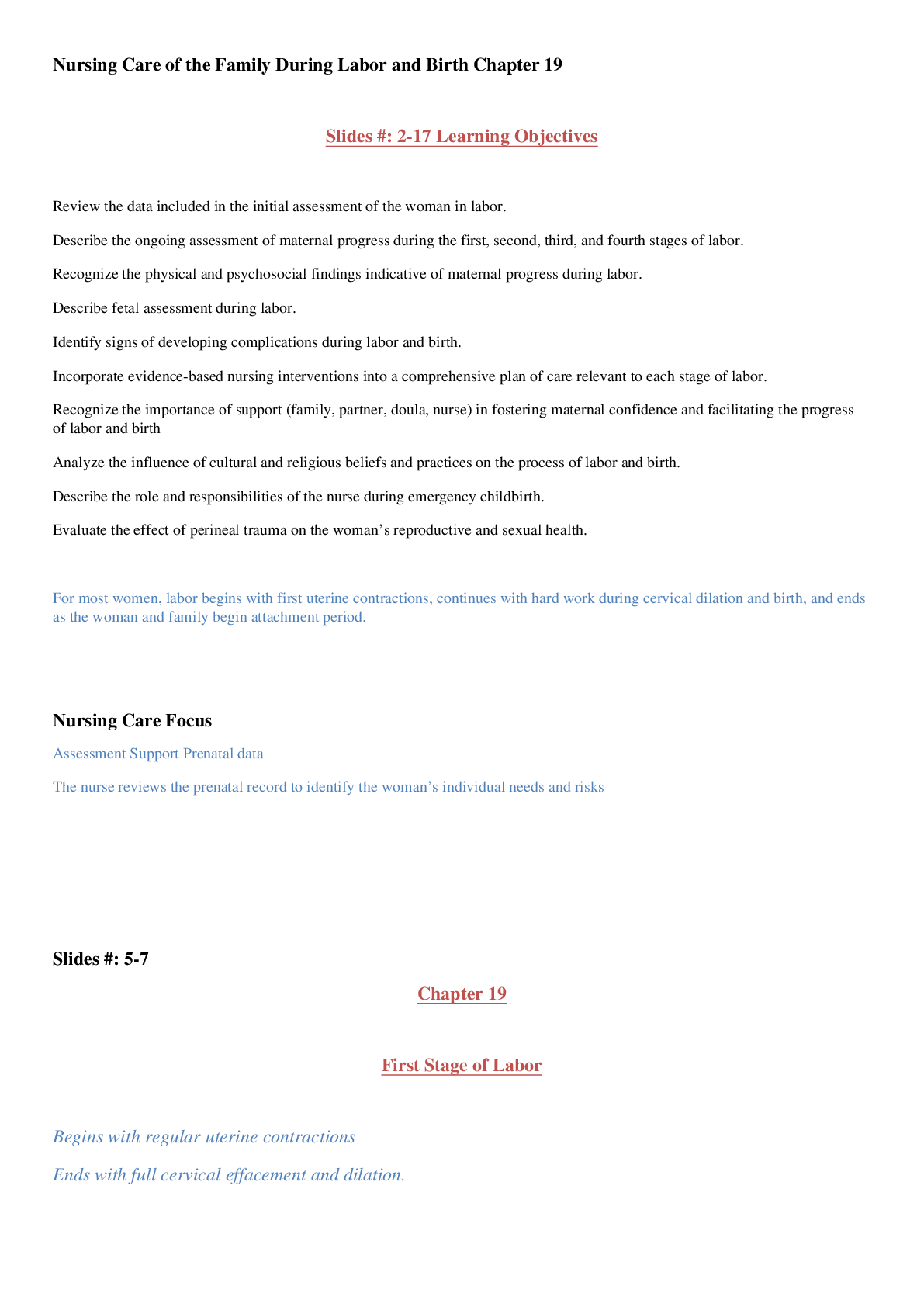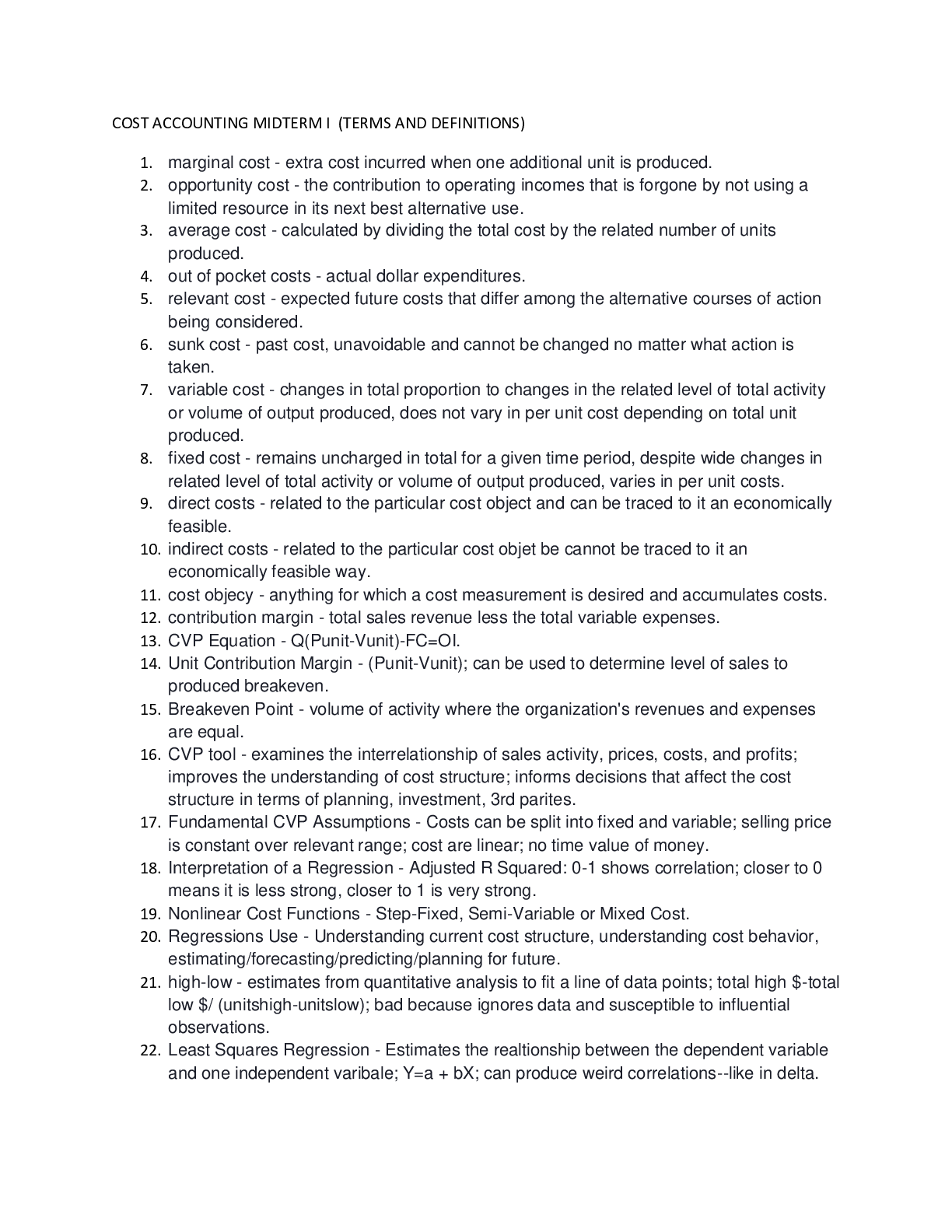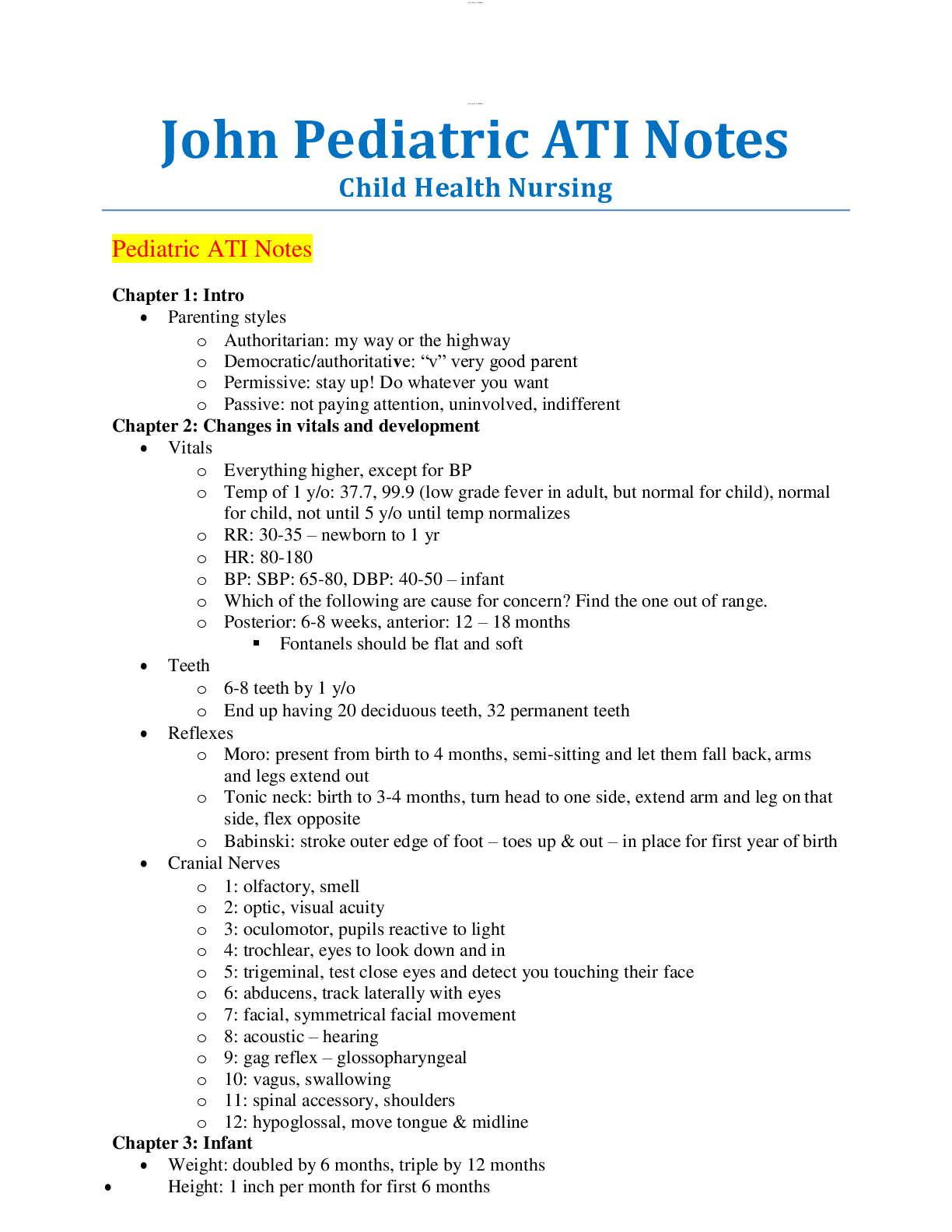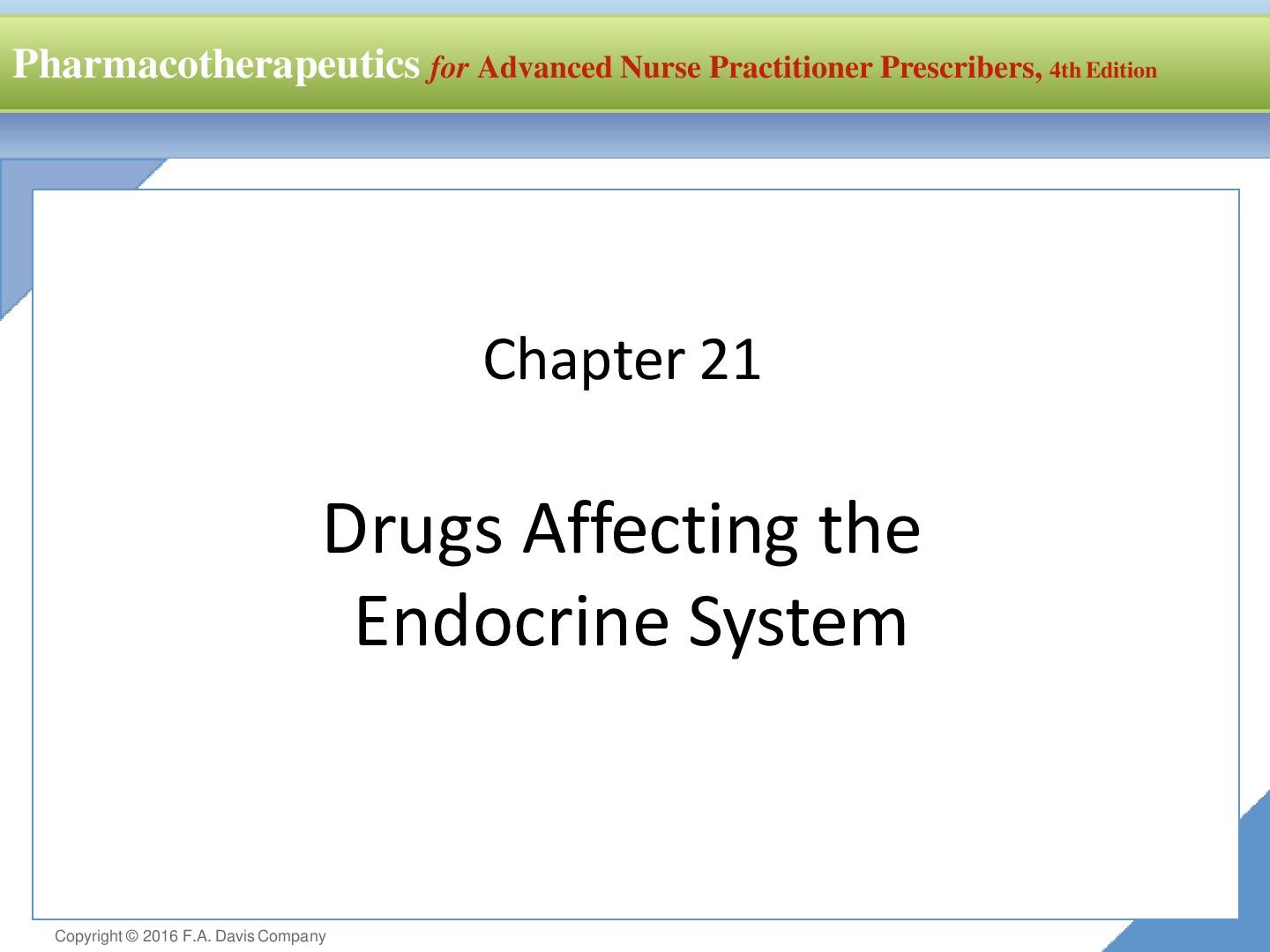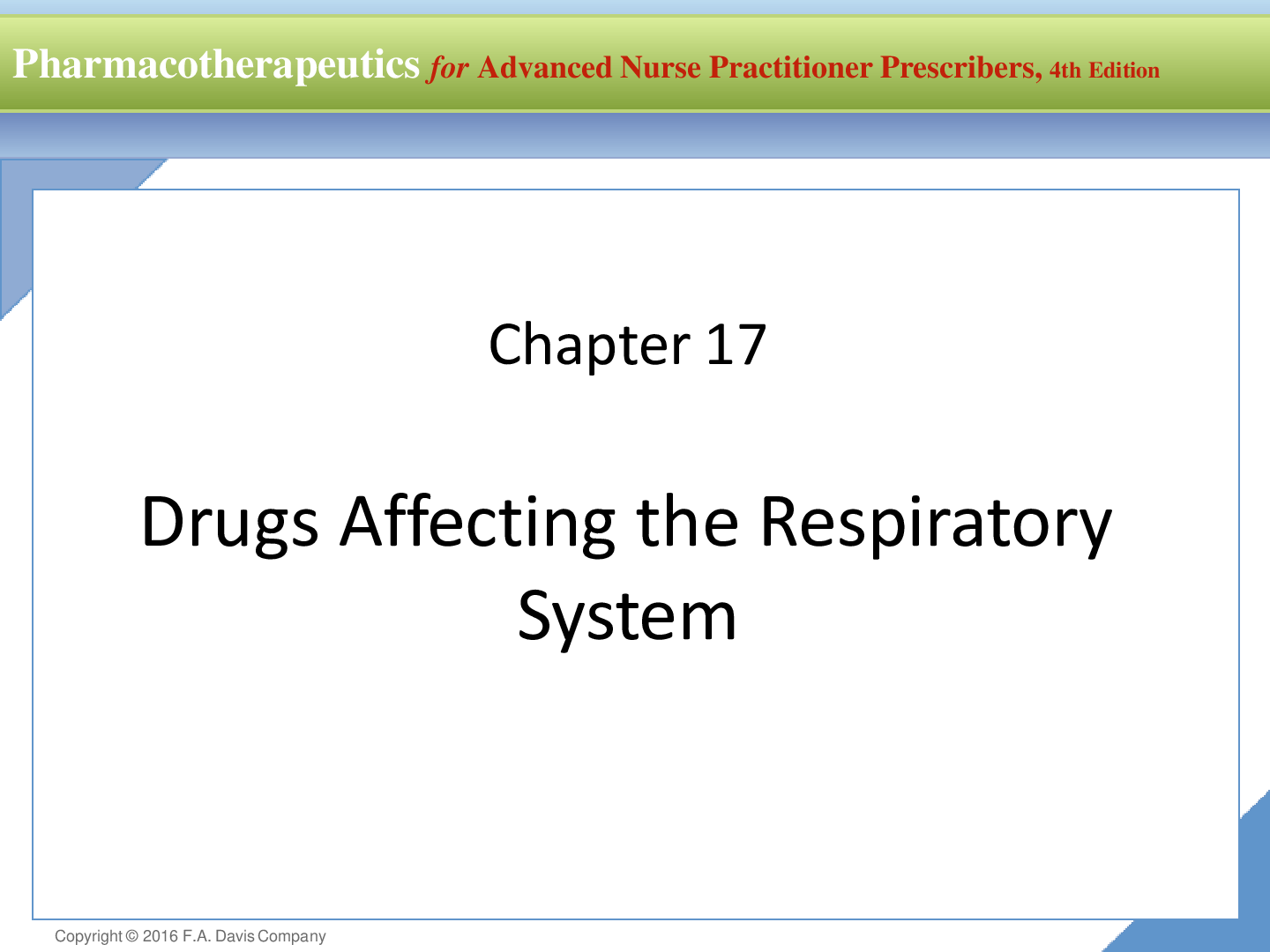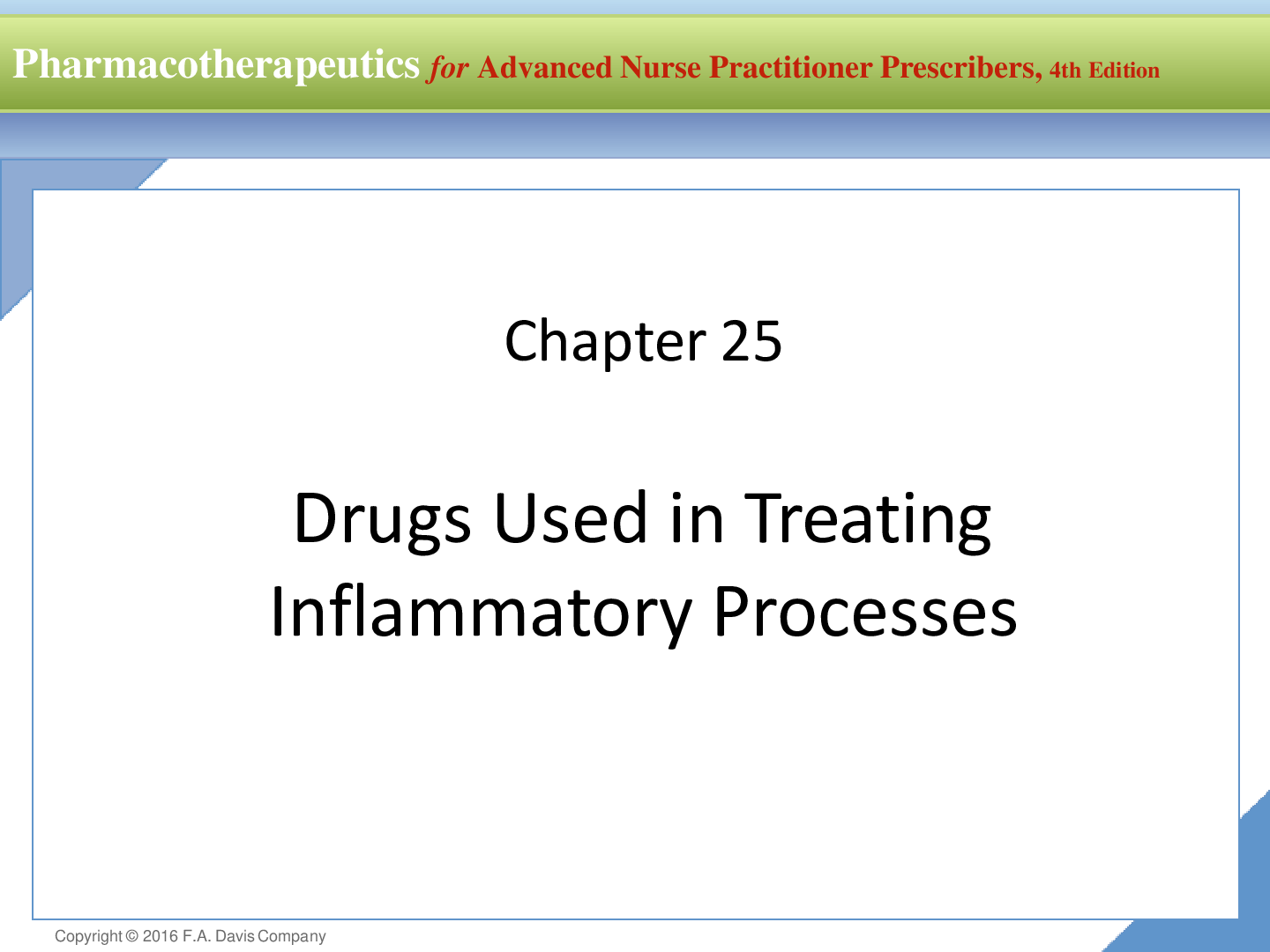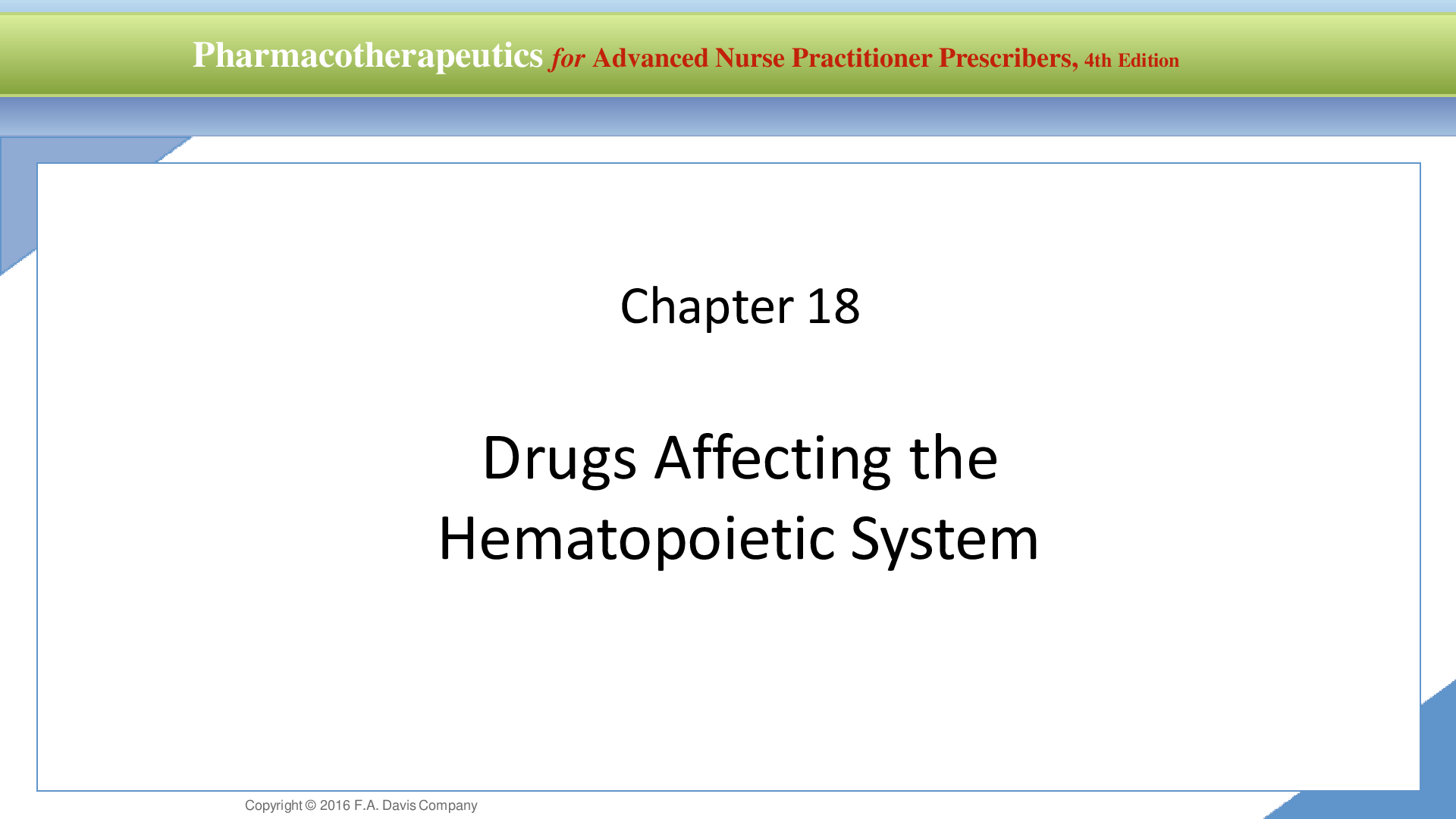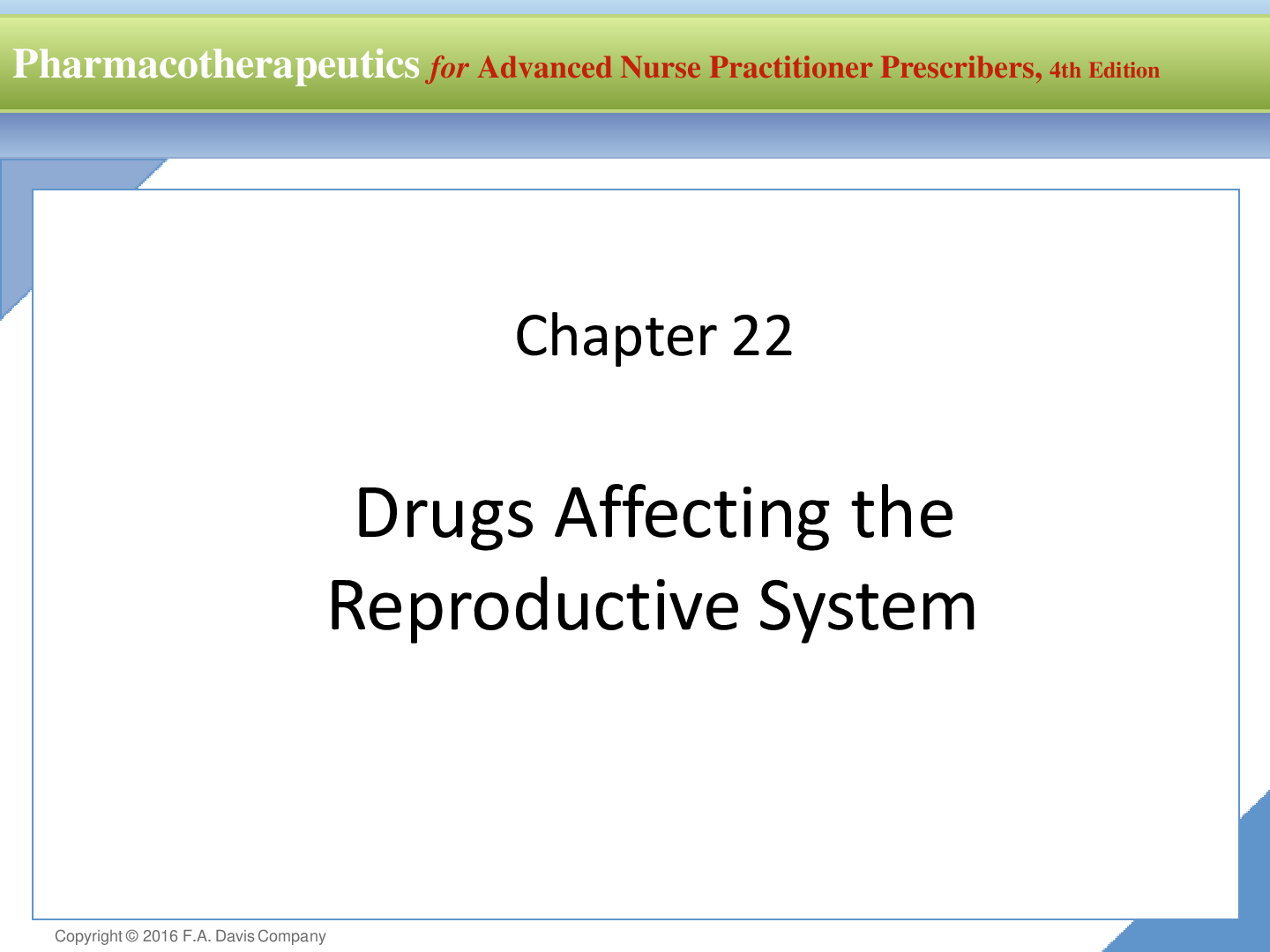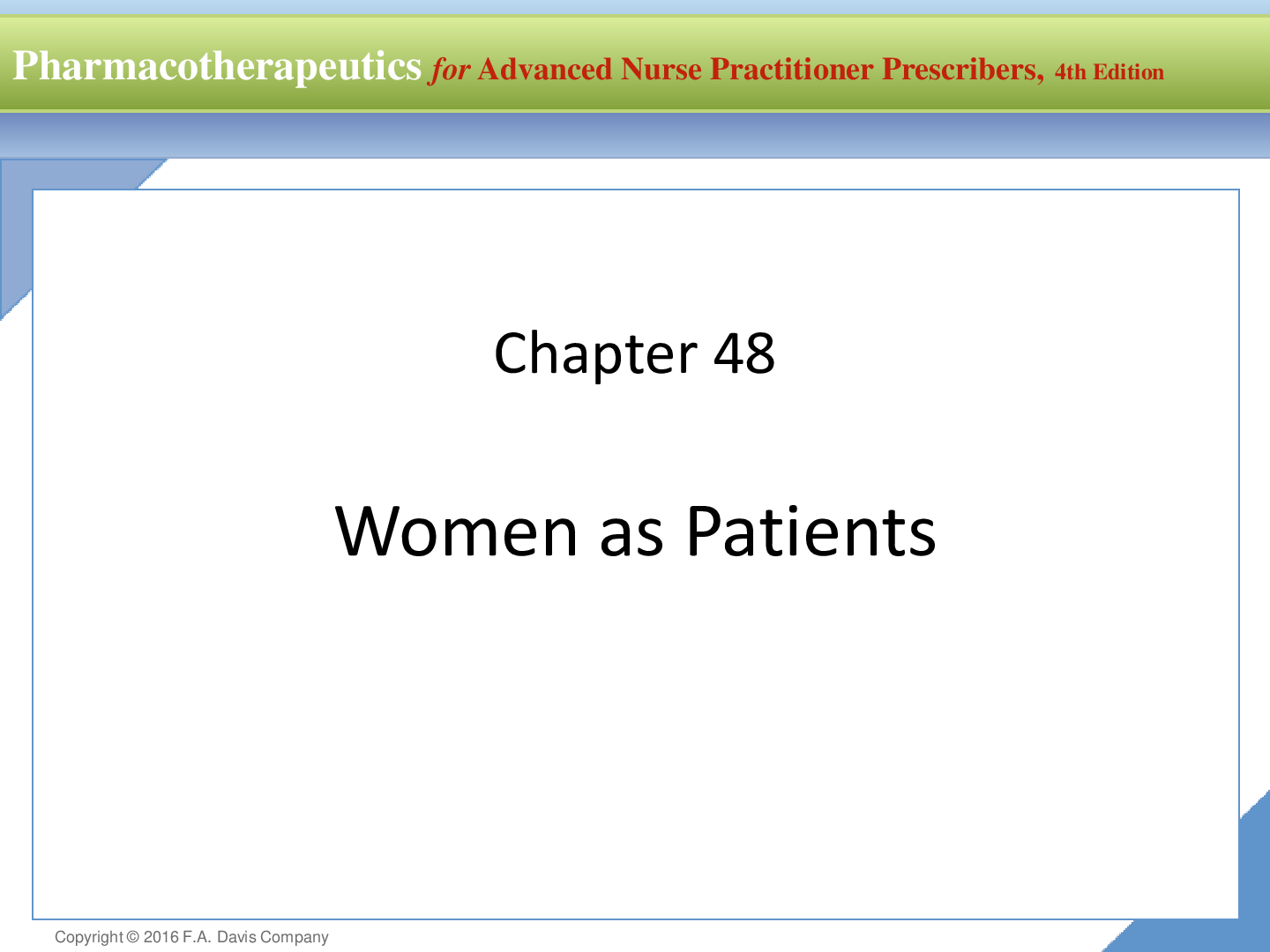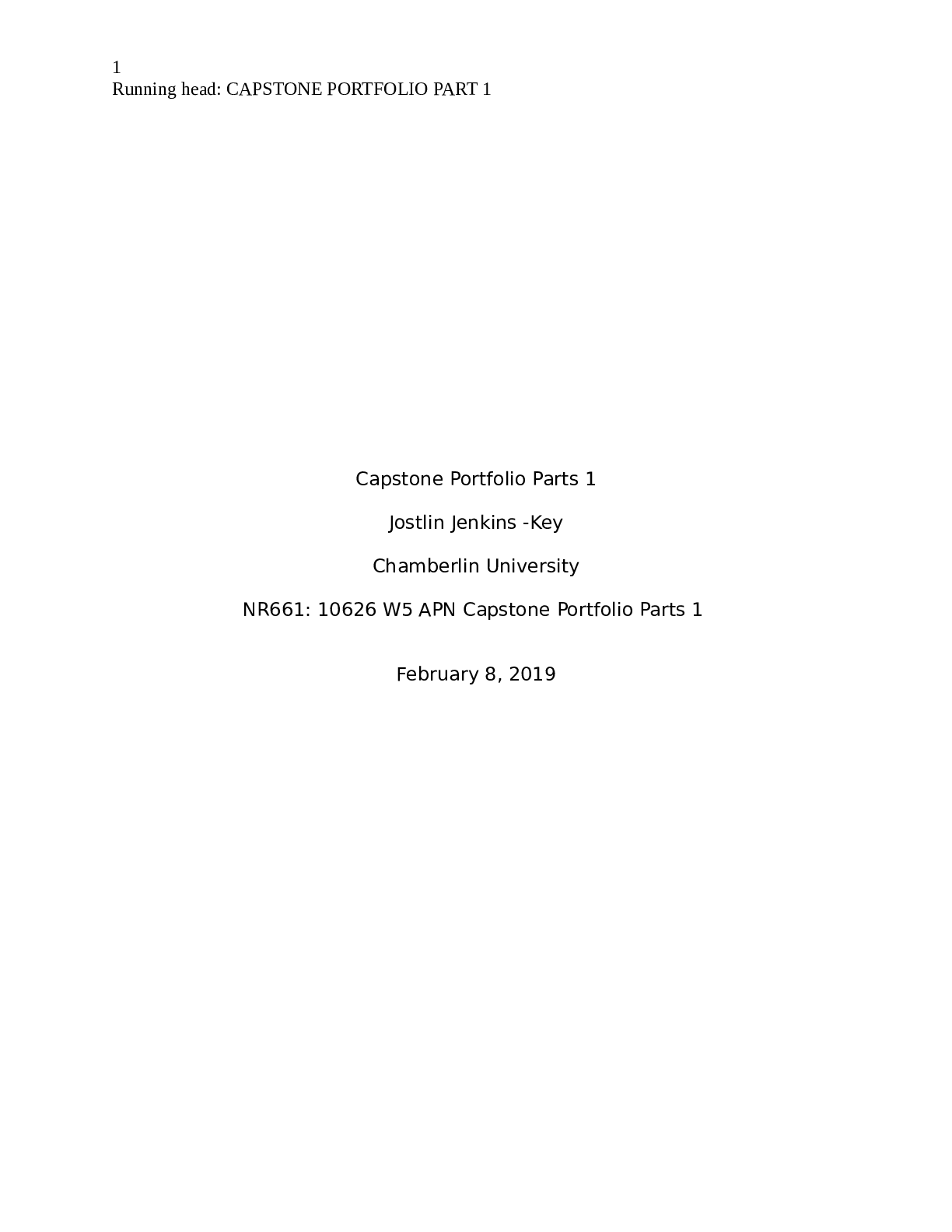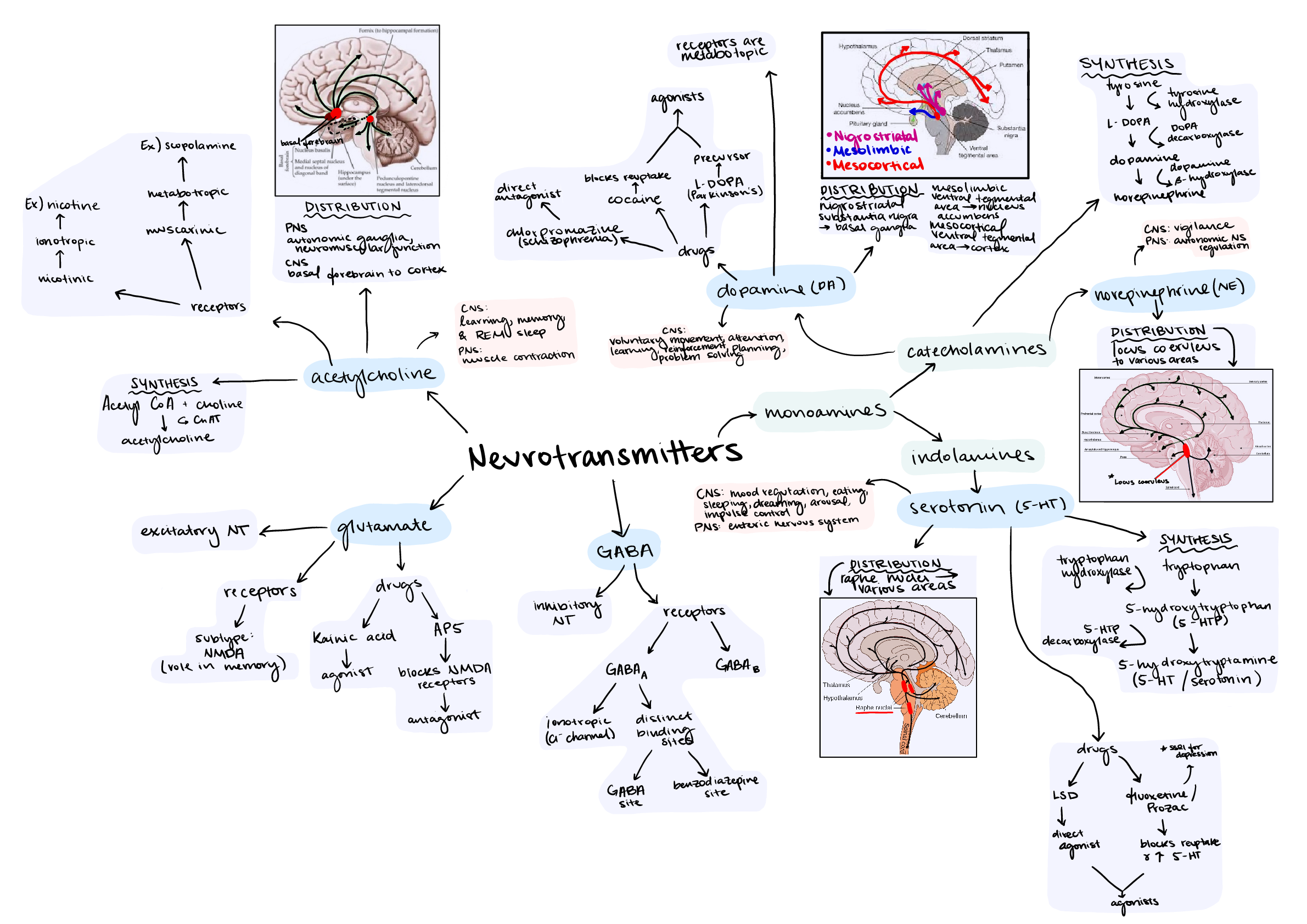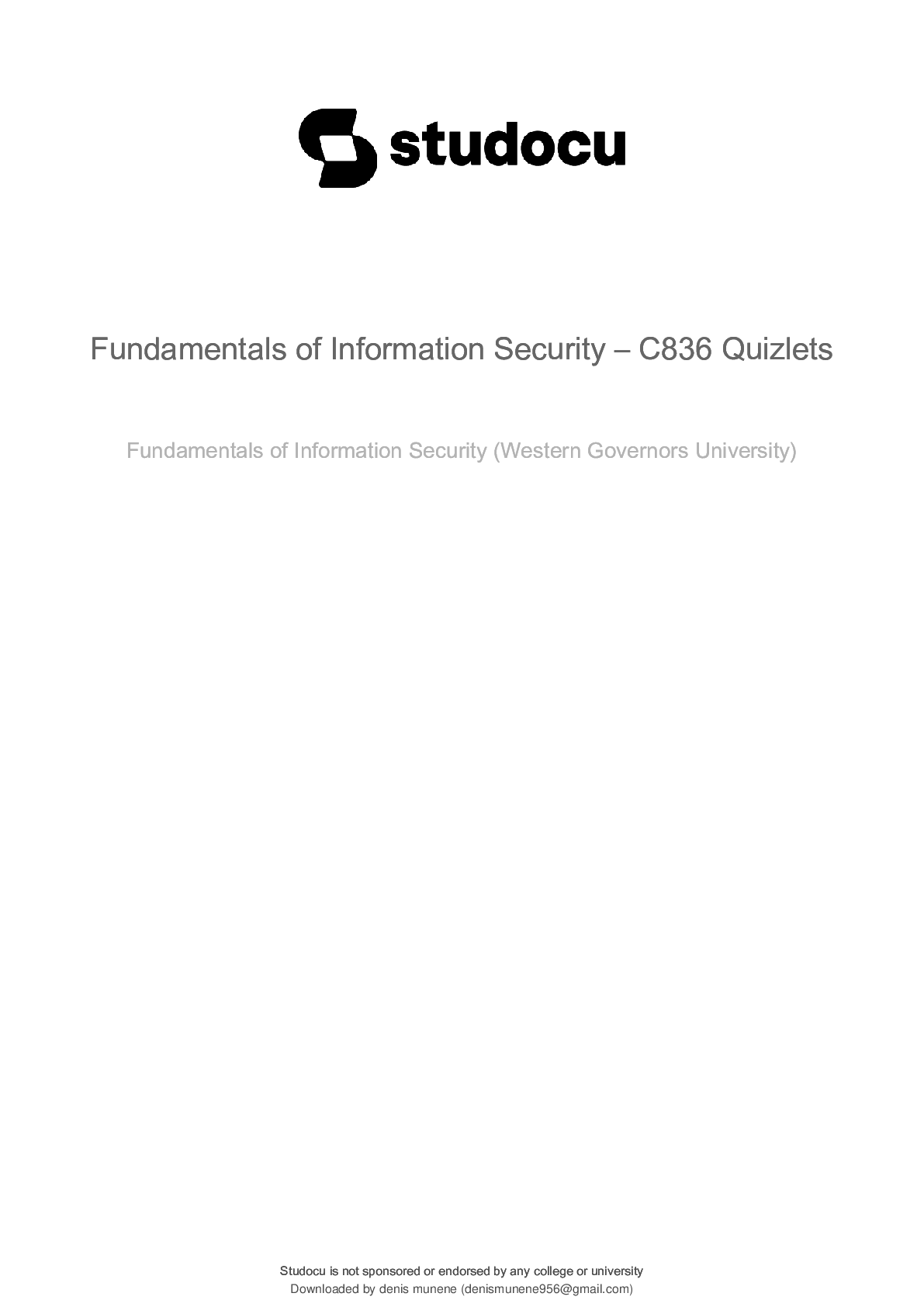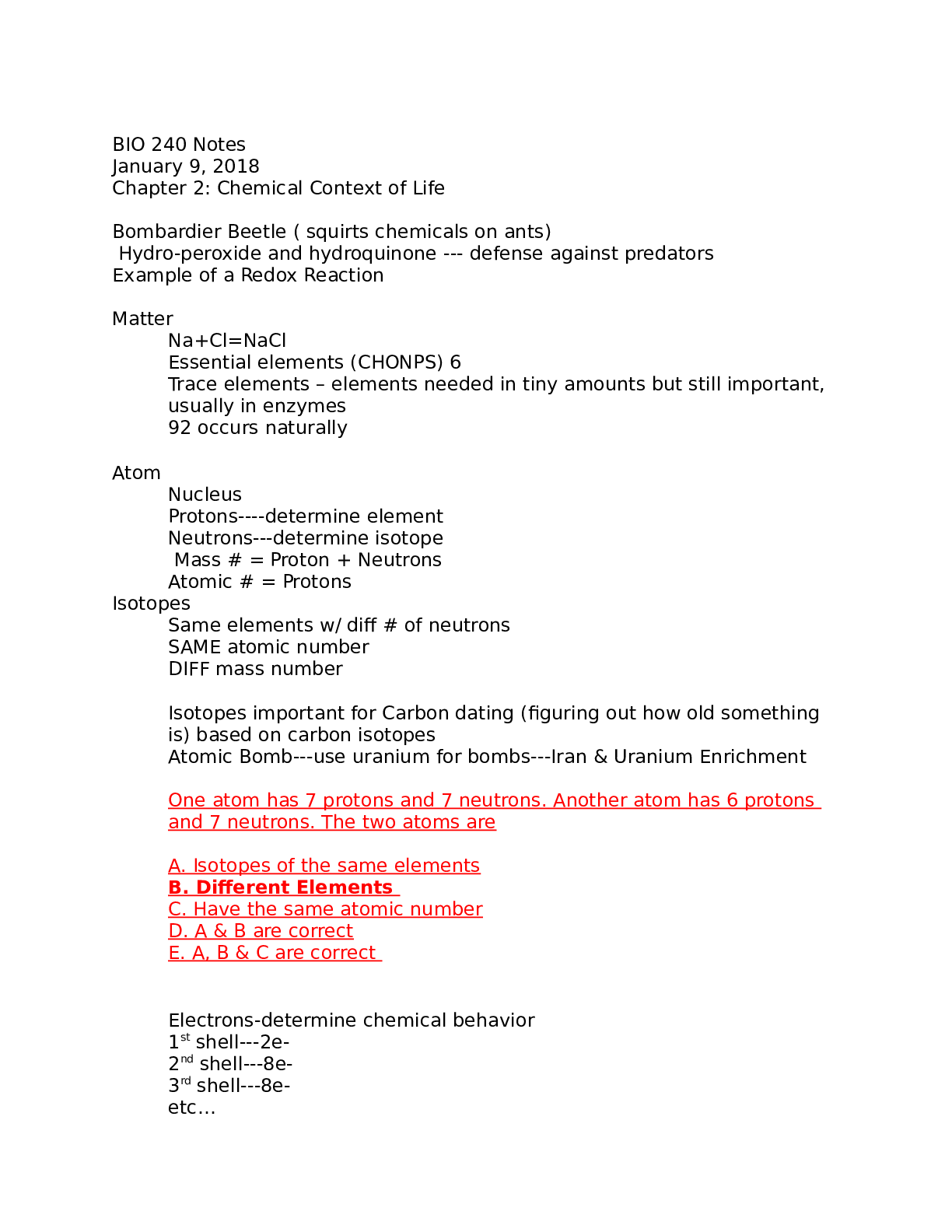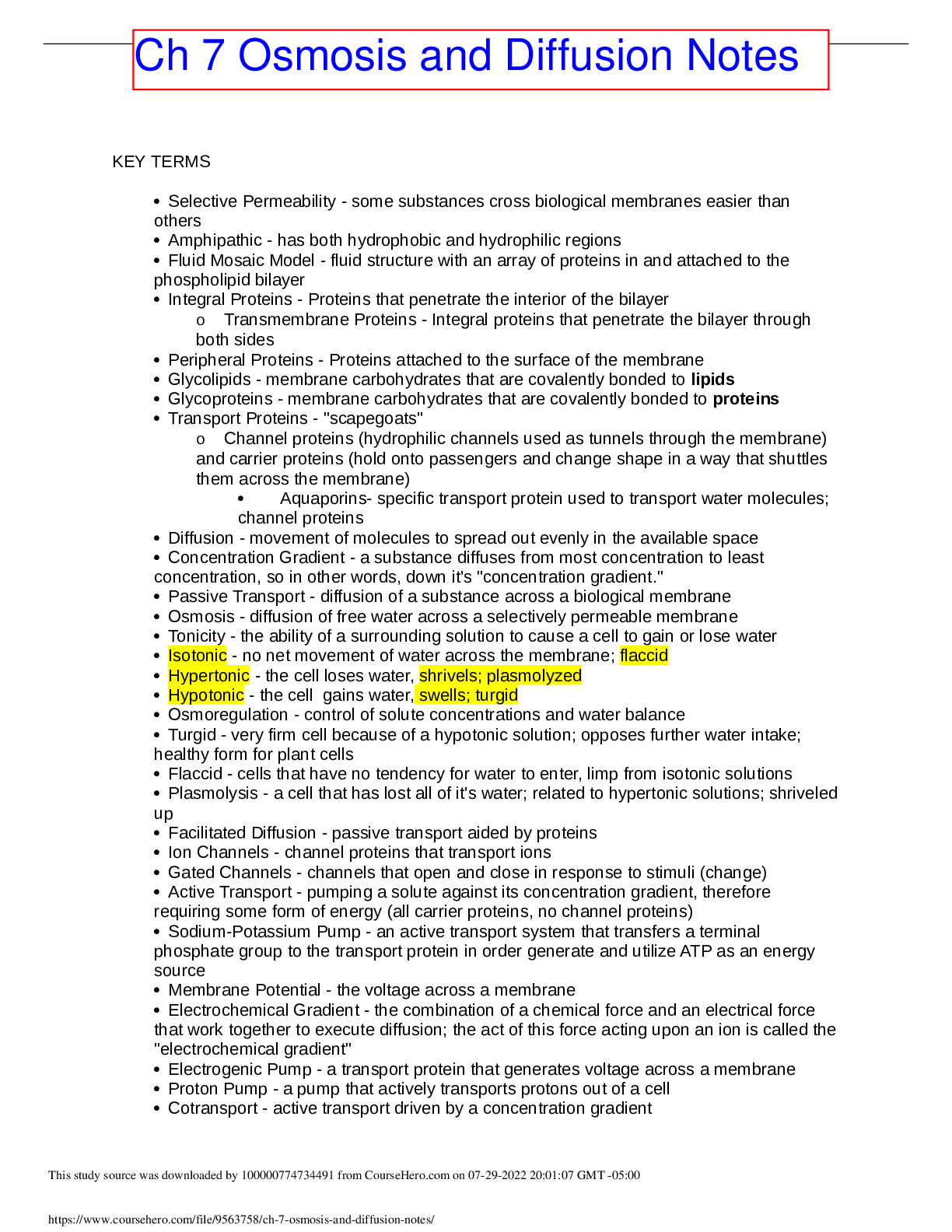*NURSING > Class Notes > PNUR 104 Theory Week 2 - Day 1 Reading notes,100% CORRECT (All)
PNUR 104 Theory Week 2 - Day 1 Reading notes,100% CORRECT
Document Content and Description Below
PNUR 104 Theory Week 2 - Day 1 Reading notes Theory Week 2 - Day 1 Reading notes (Kozier pg 54, 212, 213) Nursing metaparadigm and Theories - Nursing theories address and specify relationshi... ps among four major abstract concepts referred to as the metaparadigm of nursing—the most global philosophical or conceptual framework of a profession. - A theory is a supposition or system of ideas that is proposed to explain a given phenomenon. For example, Newton proposed his theory of gravity to explain why objects always fall to the ground. - A conceptual framework is more abstract than a theory. As noted earlier, a conceptual framework is a group of related concepts. - A metaparadigm is a higher level of abstraction than a paradigm. - It identifies the concepts central to the discipline without relating them to the assumptions of a particular paradigm. - The metaparadigm concepts as originally identified by Fawcett are as follows: 1. Person or client: the recipient of nursing care (includes individuals, families, groups, and communities) 2. Environment: the internal and external surroundings that affect the client, which includes people in the physical environment, such as families, friends, and significant others 3. Health: the degree of wellness or well-being that the client experiences 4. Nursing: the attributes, characteristics, and actions of the nurse providing care on behalf of, or in conjunction with, the client Concept of Holism - Nurses are concerned with the individual as a whole, that is, with the complete, or holistic, person, not as an assembly of parts and processes. - The terms holistic and holism are derived from the Greek word meaning “whole.” - In holistic theory, a living organism is seen as an interacting, unified whole that is more than the mere sum of its parts. - any disturbance in one part is a disturbance of the whole system or being - The social determinants of health reinforce the concept of holism, and demonstrate clearly how the health status of an individual is related to many factors, most of which are social factors. - When applied in nursing, the concept of holism emphasizes that nurses must keep the whole person in mind and strive to understand how one area of concern, relates to the whole person. - The nurse must also consider the relationship of the individual to the external environment and to others. For example, in helping a man who is grieving over the death of his spouse, the nurse should explore the impact of the loss on the whole person (i.e., on the man’s appetite, rest and sleep patterns, energy level, sense of well-being, mood, usual activities, family relationships, and relationships with others). - Nursing interventions are directed toward restoring overall harmony, so they depend on the man’s sense of purpose and meaning of his life. (Assessment of Individual’s) - Assessment is the first part of the nursing process - Components of this assessment may include the health history and physical examination, physical fitness assessment, lifestyle assessment, health-risk appraisal, health beliefs review, cultural assessment, spiritual health assessment, social support systems review, and life-stress review. Health Appraisal: - The health appraisal begins with a complete health history. - The health history is one of the most effective ways of identifying existing or potential health problems and the individual’s current methods of coping with these health issues (see Chapter 28). For instance, the client may have modified his choice of food to cope with dental pain when chewing. If further evaluation is indicated, a referral is made to the appropriate health care professional. - When the focus is on health, the appraisal includes information on lifestyle behaviors and health beliefs, with the recognition that the health issue may have effects on other aspects of the individual’s life. - The person dealing with chest pain may have changed her exercise and work behaviors significantly. - The nurse uses data from the health appraisal to formulate a health profile. The health profile provides the data necessary to determine wellness or to establish a needs profile or a nursing diagnosis and to plan appropriate nursing interventions to promote optimal health through lifestyle modification. Health Beliefs: - To promote health, the nurse must understand the health beliefs of individuals. Health beliefs may reflect a lack of information or misinformation about health or disease. - For instance, a client diagnosed with a back condition may believe that surgery is the only effective treatment, whereas health care professionals may prescribe exercises to improve the condition. The client’s belief may limit his willingness to do the exercises. - Clients’ beliefs also include folklore and practices from different cultures. - Many clients may have outdated information about health, illness, treatment, and prevention. - The nurse is frequently in a position to assess the client’s current health practices, give the latest information or to correct misconceptions. - For instance, a person who has a cultural background that includes traditional medicines for certain conditions may be using those remedies, often without discussion with health personnel. - Those remedies may interact with other treatments prescribed for the condition. For additional information on health beliefs, see Chapters 7, 8, and 11. Coping Mechanisms: - Individual coping mechanisms are the behaviors individuals use to deal with stress or changes. Coping mechanisms can be viewed as an active method of problem solving developed to meet life’s challenges. - The coping mechanisms individuals develop reflect their own resourcefulness. Many individuals modify their daily routines in order to cope with symptoms of their conditions, such as the person who sleeps in a downstairs room as she is unable to climb stairs because of shortness of breath. - Individuals may use the same coping patterns rather consistently over time or may change their coping strategies when new demands are made on them. - Not all coping strategies are positive and may result in other health issues, such as the person who uses alcohol to avoid dealing with some emotional issues. - Nurses working with individuals realize the importance of assessing coping mechanisms as a way of determining how individuals relate to stress. - Also important are the resources available to the individual. Internal resources, such as knowledge, skills, effective communication patterns, and a sense of purpose, assist in the problem-solving process. - Age and the individual’s developmental stage often bring with them experiences that may or may not support positive coping strategies. - For instance, an individual may seek the support of the local foodbank when he is unable to provide sufficient food for himself because of financial issues. - Another individual with the same issues may go without adequate food or seek the support of extended family. In addition, external - support systems promote coping and adaptation. Risk for Health Problems: - Risk assessment helps the nurse identify individuals at higher risk than the general population of developing specific health problems, such as a cerebrovascular accident, diabetes, or lung cancer. - The vulnerability of individuals to health problems may be based on age, hereditary or genetic factors, gender or race, cultural factors, sociological factors, and lifestyle practices. Developmental factors: - Individuals at both ends of the age continuum are at risk of developing health problems. Young children lack the knowledge, skills, and experience to establish a repertoire of coping strategies. - Some older adults feel a lack of purpose and decreased self-esteem. - As an example, the older person experiencing significant body changes related to osteoporosis (humped back and spinal twisting, resulting in the need for a walker) may avoid social events outside the home, and thus experience social isolation. - These feelings, in turn, reduce his or her motivation to engage in health-promoting behaviors, such as exercise or community and family involvement. Hereditary factors: - Individuals born into families with a history of certain diseases, such as diabetes or cardiovascular disease, are at greater risk of developing these conditions. - A detailed individual and family history, including genetically transmitted disorders, is essential to the identification of individuals at risk. - These data are used not only to monitor the health of individuals but also, to recommend modifications in lifestyle and health practices that potentially reduce the risk, minimize the consequences, or postpone the development of genetically related conditions. Gender or Race: - Some individuals may be at risk of developing a disease by reason of gender or race. - Males, for example, are at greater risk of having cardiovascular disease at an earlier age compared with females, and females are at greater risk of developing osteoporosis, particularly after menopause. - Although it is sometimes difficult to separate genetic factors from cultural ones, certain risk factors seem to be related to race. - Sickle-cell anemia, for example, is a hereditary disease predominantly affecting people of African descent. - Compared with the general population in Canada, Indigenous or Aboriginal people seem more susceptible to certain diseases, such as diabetes Cultural Factors: - Culture creates an atmosphere that influences the health beliefs and practices of an individual. - To understand cultural factors, the nurse needs to explore with the individual his cultural practices relevant to his health. - To provide culturally sensitive care, nurses need to recognize and understand a broad spectrum of cultural values, beliefs, and practices but also the extent to which the individual adheres to those practices (see Chapter 11). Sociological Factors: - The individual’s health is influenced by a variety of sociological factors, the most noteworthy of which is poverty. - Poverty is a major problem that affects the health of the individual. - If an individual is born into or grows up in a single-parent family headed by a female, then the risk of poverty increases. - Other factors include the person’s roles within society, at work, and in the community, and personal interests and activities. Lifestyle: - It has become clear that many diseases are preventable, that the effects of some diseases can be minimized, or that the onset of certain diseases can be delayed through lifestyle modifications. - Cancer, cardiovascular disease, type 2 diabetes, and tooth decay are among lifestyle- related diseases. - The incidence of lung cancer, for example, would be greatly reduced if people never smoked. - Good nutrition, dental hygiene, and use of fluoride—in the water supply, in toothpaste, or as topical supplements—have been shown to reduce caries (dental decay). - One of the most important lifestyle-related issues today is obesity. - Obesity has become pandemic in Canada, leading to numerous negative health effects. - Other important lifestyle considerations are exercise, stress management, and rest. - Today, nurses have the knowledge to prevent or minimize the effects of some of the main causes of disease, disability, and death. - The challenge for health care professionals is to disseminate information about prevention and to motivate individuals to make lifestyle changes before the onset of illnesses. AREAS OF STRENGTH: - Resilience is “the process of adapting well in the face of adversity, trauma, tragedy, threats or significant sources of stress—such as family and relationship problems, serious health problems or workplace and financial stressors. It means ‘bouncing back’ from difficult experiences (Read more on 215) What is Family? - Standards of family structure have shifted dramatically over the past three decades. Couples now often postpone childbearing while engaged in prolonged periods of education or establishment of careers. - Rising rates of divorce and remarriage have resulted in more blended and lone-parent families. Increased family mobility has also shifted the roles of extended family members. These changes challenge definitions of family based on long-held assumptions - Persons choosing to define themselves as family may or may not be bound by blood or legal status. The following definition attempts to be open and respectful of the many different way’s families may organize themselves. - The Vanier Institute of the Family (2015) defines family both in terms of the individuals and their roles—as any combination of two or more persons who are bound together over time by ties of mutual consent, birth and/ or adoption, or placement and who, together, assume responsibilities for variant combinations of some of the following: 1. Physical maintenance and care of group members 2. Addition of new members through procreation or adoption 3. Socialization of children 4. Social control of members 5. Production, distribution of goods and services, consumption 6. Affective Nurturance – love Types of Families in Today’s society - Family may be described in different ways according to biological relatedness, cultural norms, social ties, interactions, or proximity. - Scholarly definitions often focus on structure (e.g., biological or legal ties), function (e.g., caretaking or financial support), or transactions (e.g., creation of shared meaning through affective ties or symbolic communication such as stories and rituals), while lay definitions often blend the elements Some common types of “Family” include the following: • Traditional—both parents reside in the home with children; mother assumes nurturing role, and father provides economic necessities • Two careers—both husband and wife are employed • Lone parent—one parent with child(ren) • Adolescent—an infant is born to adolescent parents • Blended—existing families that join together to form a new one • Cohabiting—unrelated individuals or families who live under one roof • Adoptive—children are adopted by parent(s) • Mixed race—parents and/or children of different ethnicities • Nuclear—parent(s) and child(ren) from same generation • Mixed generation—parent(s) and child(ren) from several Generations • Gay or lesbian—same-sex couple Family Nursing - Family nursing refers to relational practices that involve family members in care, respond to their concerns, or provide information and emotional support. - Care of family members calls for nursing practices that occur within conversation and relationship, across every health care setting. You will notice that the terms patient and client are both used in this chapter, as nursing care of families can occur in inpatient and community settings. - Each encounter with families in nursing practice affords a possibility for nursing of families. Family members may be present when the home care nurse visits. - They may be at the bedside of an ill family member. The nurse may conduct a formal family assessment interview upon the patient’s admission to a facility. - The nurse may also be involved in a conference with family and other health care team members to facilitate decision making, treatment planning, or discharge. - In some situations, the nurse has little or no direct contact with family members of the individual client, yet the needs and concerns of family members may still be addressed in their absence. - Although the individual is the focus of care, the extent to which family members are involved in health care encounters varies. Many health care facilities now provide structural supports to include family members and value their presence and contribution to care. - These supports include open or flexible visiting policies, comfortable waiting rooms and access to overnight facilities, refreshments, telephones, and increased access to information from health care professionals. - Indeed, many agencies now have adopted a Patient and Family-Centered Care (PFCC) approach to the planning, delivery, and evaluation of health care that is grounded in mutually beneficial partnerships among patients, families, and health care providers. Core concepts of the IPFCC (Institute for Patient and Family-Centered Care) include the following: 1. Dignity and Respect: Health care practitioners listen to and honor patient and family perspectives and choices. Patient and family knowledge, values, beliefs, and cultural backgrounds are incorporated into the planning and delivery of care. 2. Information Sharing.: Health care practitioners communicate and share complete and unbiased information with patients and families in ways that are affirming and useful. Patients and families receive timely, complete, and accurate information to effectively participate in care and decision making. 3. Participation: Patients and families are encouraged and supported in participating in care and decision making at the level the patient chooses. 4. Collaboration: Patients, families, health care practitioners, and leaders collaborate in policy and program development, implementation, and evaluation; in health care facility design; and in professional education as well as in the delivery of care. - Clearly, nurses need family theory to provide truly relevant care, given that the family is the fundamental unit of society with norms, values, and roles distinct from that of the individual [Show More]
Last updated: 1 year ago
Preview 1 out of 7 pages
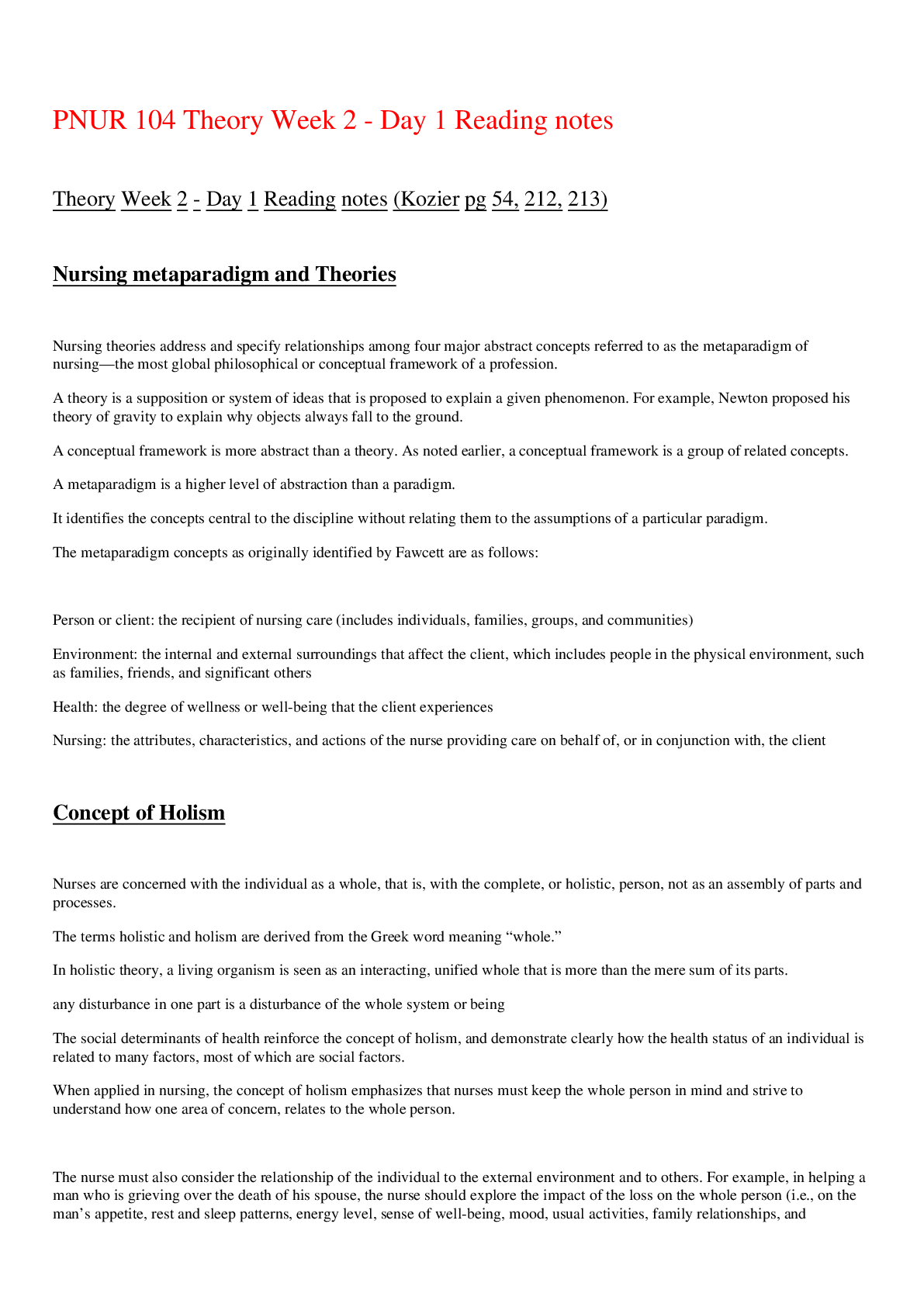
Reviews( 0 )
Document information
Connected school, study & course
About the document
Uploaded On
Mar 15, 2023
Number of pages
7
Written in
Additional information
This document has been written for:
Uploaded
Mar 15, 2023
Downloads
0
Views
56

